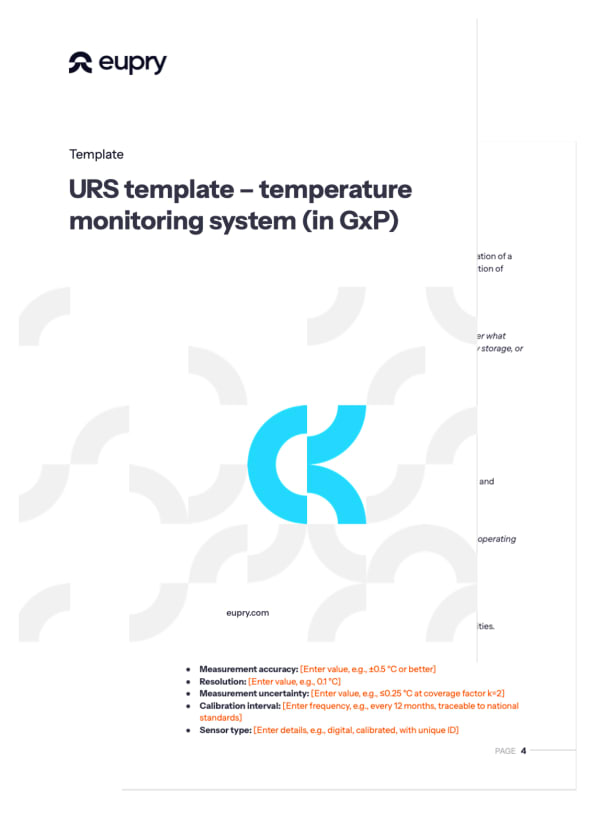How to create a URS for temperature monitoring in GxP

Adam Hartmann-Kruckow
Best practices, pitfalls, and templates
Learn how to design a lasting, efficient URS that leads to lasting, efficient compliance – aligned with WHO and ISPE guidelines – for your temperature monitoring systems.
Get a structured starting point aligned with WHO and ISPE to help you design your URS and capture all relevant requirements to ensure consistent, audit‑ready monitoring of all environments.

Why your URS is the backbone of monitoring compliance
A well‑written User Requirement Specification (URS) for a temperature monitoring system sets the foundation for selecting a solution that will support compliance, protect product quality, and adapt to future needs. In regulated environments, it is your tool for ensuring systems are built to meet operational demands and satisfy inspectors. Without clear requirements, you risk costly retrofits, compliance gaps, or choosing technology that cannot grow with your business.
This guide provides practical, step‑by‑step guidelines for creating a URS for temperature monitoring that works in real life, not just on paper. It also links you to deeper resources, examples, and templates you can adapt directly.
Also read: Reduce risks with Eupry’s automated temperature monitoring solution
How to create a URS for temperature monitoring in GxP
Follow these steps to ensure your URS is complete, compliant, and easy for suppliers to respond to:
1. Define scope and objectives
Describe the purpose of the system, where it will be used, and what it must achieve.
Include, for instance:
- All relevant environments — cold rooms, freezers, ambient storage, refrigerated transport
- Number of sites and their locations
- Operating conditions (seasonal changes, humidity, product categories)
- Criticality of monitored products
Pro tip: Write this section so a supplier with no prior knowledge of your facility could still understand your needs.
** Also read**: How to write a URS for pharmaceutical storage areas and TCUs
2. Anchor in regulations
List every standard the system must comply with, for instance:
- EU GMP Annex 15 – qualification and validation
- WHO GDP Technical Supplement – temperature mapping
- 21 CFR Part 11 – electronic records and data integrity
- ISPE guidance – controlled temperature chamber mapping and monitoring
If you need a broader overview of qualification and validation requirements, see our CQV validation guide for pharma.
3. Specify technical requirements
Cover both minimum acceptable performance and future‑proof capabilities:
- Measurement accuracy, resolution, and uncertainty limits
- Calibration frequency and traceability to ISO 17025 standards
- Scalability to add or remove sensors without triggering re‑validation
- Wireless or manual data transfer requirements
- Sensor placement flexibility following updated mapping results
- Environmental tolerance for sensors (temperature, humidity)
Pro tip: For details on placement strategies, see URS for temperature mapping in GxP.
4. Detail data integrity and security
Define exactly how data should be managed:
- Audit trails with secure login and role‑based permissions
- Data retention periods aligned with regulations
- Backup frequency and maximum acceptable recovery time
- Encryption during storage and transmission
5. Set alarm and deviation handling rules
Explain your expectations for:
- Alarm thresholds per storage area
- Notification channels and escalation procedures
- Documentation of deviations and corrective actions
- Frequency of alarm testing and verification
6. Plan integration and ongoing maintenance
Specify how the system will fit into your operational and quality framework:
- Integration with BMS, QMS, or other relevant systems
- Preventive maintenance plans and responsible parties
- Service level agreements for repairs and support
- Digital storage and traceability for calibration certificates
Also see our on-demand webinar on URS design: How to create a flexible URS for temperature monitoring and mapping
Next steps
Once your URS is complete, share it with shortlisted suppliers and use it during demos and evaluations to confirm compliance and functionality.

Download your URS template
Get a free URS template to save time and ensure completeness when creating your URS for temperature monitoring systems in GxP.
4 tips for writing an effective URS for monitoring
A well‑crafted URS for temperature monitoring ensures your system meets current compliance demands and remains adaptable for the future.
Keep these tips in mind:
- Use clear, measurable requirements: Avoid vague terms like “high accuracy” and instead specify performance metrics, such as “accuracy ±0.5 °C” or “uncertainty ≤0.25 °C, k=2.” Measurable criteria make it easier for suppliers to demonstrate compliance and for you to verify performance.
- Involve Quality, Engineering, and IT from the start: These teams bring different perspectives that help you cover compliance, operational, and technical needs in one document. Collaboration early in the process avoids rework later.
- Align requirements to risk levels: Identify high‑risk areas that need stringent controls and avoid over‑engineering in low‑risk areas. This approach ensures efficient use of resources and reduces unnecessary complexity.
- Reference relevant regulations for each requirement: Link each clause to applicable standards and guidelines such as WHO, GxP, ISPE, or 21 CFR Part 11. This makes the URS easier to defend during audits and helps maintain alignment with evolving regulatory expectations.
Also see: SCADA wireless monitoring for GMP pharma
Common pitfalls to avoid
Even experienced teams can make mistakes when drafting a monitoring URS.
Here are some common issues to be aware of:
- Copy‑pasting a generic URS without tailoring it to your setup: This can result in irrelevant requirements or missing critical needs specific to your environment.
- Omitting measurement uncertainty: While accuracy is often stated, uncertainty is just as important for proving compliance. Leaving it out can raise audit questions.
- Skipping escalation procedures for alarms: Without clear escalation paths, critical temperature deviations may not be addressed quickly enough to protect product integrity.
- Forgetting to define integration needs until after purchase: Integration with existing monitoring, building management, or quality systems is often essential. Not specifying this early can lead to expensive modifications or workarounds later.
Learn more
See, for instance:
- URS in temperature compliance guide
- [URS for temperature mapping in GxP](/temperature-mapping/urs-template]
- CQV validation guide for pharma.
Frequently asked questions about URS design for temperature monitoring
URS template: What should YOUR monitoring system include?
A well‑written URS is the best route to ensure you choose the right system for you. This template provides a structured starting point aligned with WHO and ISPE to help you design your URS and capture all relevant requirements to ensure consistent, audit‑ready monitoring of all environments.
